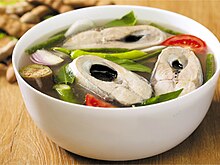Sinigang
siling mahaba, tomatoes | |
| Variations | Pork, beef, shrimp, fish, chicken |
|---|---|
| ~120 kcal | |
| Similar dishes | Pinangat na isda, paksiw, kansi, kadyos, baboy, kag langka |
| Other information | Can be served in many different forms |
Sinigang is a Filipino soup or stew characterized by its sour and savory taste. It is most often associated with tamarind (Filipino: sampalok), although it can use other sour fruits and leaves as the souring agent such as unripe mangoes or rice vinegar. It is one of the more popular dishes in Filipino cuisine. This soup, like most Filipino dishes, is usually accompanied by rice.
Origin
Sinigang means "stewed [dish]", it is a nominalized in the form of Tagalog verb sigang, "to stew".[1] While present nationwide, sinigang is seen to be culturally Tagalog in origin, thus the similar sour stews and soups found in the Visayas and Mindanao (like linarang) are regarded as different dishes and differ in the ingredients used. Fish sauce is a common condiment for the stew.
Ingredients

Sinigang is most often associated with
Sinigang typically uses meat or seafood (e.g., fish, pork, beef, shrimp, or chicken) stewed with
Sinigang variations



- Sinigáng sa misô - Sinigang with miso added to the soup as the umami element, usually with a tamarind base
- Sinigáng sa bayabas - Sinigang that uses guava as the sour soup base
- Sinigang sa mangga - Sinigang that uses unripe mango as the sour soup base
- Sinigang sa kalamansi - Sinigang that uses calamansi or lemon as the sour soup base
- Sinigáng na isdâ - Fish sinigang
- Sinigang sa pakwan - Sinigang that uses watermelon together with tamarind as the sour soup base
- Sinigáng na hipon - Shrimp or prawn sinigang [9]
- Sinigang na baka - Beef sinigang
- Seafood sinigang - Fish, shrimp, squid, sea shells are combined in this soup [10]
- Bule - A variant of sinigang from the
Similar dishes
Other Filipino dishes that are similar to sinigang but distinct include
There are also similar soured beef stews. They include the
Malaysia

Around the east coast of
Meanwhile, on the west coast of Peninsular Malaysia, another dish that is thought to be similar to singgang is called pindang.[22]
See also
- Cansi
- Canh chua
- Hot and sour soup
- Sayur asem
- Pindang
- Tom yum
- List of soups
- List of stews
- Filipino cuisine
References
- ^ "sigang". Tagalog-Dictionary.com. Retrieved December 16, 2018.
- ^ Pamaran, Maan D'Asis (October 12, 2016). "The Filipino-Spanish food connection". Philippine Daily Inquirer. Retrieved December 16, 2018.
- ^ "The Souring Agents of Sinigang". Our Philippine Trees. Retrieved April 17, 2019.
- ^ "Sinigang na Salmon at Bauhinia Filipino Cuisine". Flavours of Iloilo. Retrieved April 17, 2019.
- ^ The Souring Agents of Sinigang
- ^ Sinigang Recipe
- ^ Sinigang na Baboy Recipe
- ^ "Sinigang na Baboy". Kawaling Pinoy. January 27, 2013. Retrieved August 29, 2021.
- ^ Sinigang na Hipon Recipe - Pinoy Recipe at Iba pa. Retrieved March 30, 2019
- ^ Seafood Sinigang Recipe - Pinoy Recipe at Iba pa. Retrieved March 30, 2019
- ^ "Bule". Steamy Bain Marie. Retrieved November 29, 2019.
- ^ Daez, Mikael (November 3, 2013). "Saksi: Bule baluga, sinigang na pinasarap ng patani". Saksi (in English and Tagalog). GMA. Retrieved November 29, 2019.
- ^ Manalo, Lalaine. "Sinampalukang Manok". Kawaling Pinoy. Retrieved April 13, 2019.
- ^ "Sinampalukan Manok (Tamarind'd Chicken)". 80 Breakfasts. Retrieved April 13, 2019.
- ^ "Pinangat na Isda Fish Poached in Kamias and Tomatoes". Filipino-food-recipes.com. Retrieved January 10, 2019.
- ^ Belen, Jun. "How to Make Fish Pinangat (Fish Soured in Calamansi and Tomatoes)". Junblog. Retrieved January 10, 2019.
- ISBN 9789712730443.
- ^ Reyes, Gladys. "Ilonggo Food: Bacolod Cansi Recipe". Experience Negros. Retrieved October 23, 2019.
- ^ "Sinanglaw". Ang Sarap. Retrieved October 17, 2020.
- ^ "NCCA's 'Sinigang versus Adobo' poll divides the nation". GMA News Online. May 18, 2016. Retrieved January 15, 2022.
- ^ Reggie Aspiras (October 8, 2009). "'Sinigang' and 'asocena' aren't exclusive to Filipinos". Philippine Daily Inquirer. Retrieved January 17, 2022.
- ^ a b "Khasiat ikan singgang dari sudut saintifik yang sangat wow". sinarplus+ (in Malay). Retrieved January 15, 2022.
- ^ a b "Singgang Ikan Tongkol Terengganu, Lauk Lejen Kesukaan Ramai". rasa (in Malay). Retrieved January 15, 2022.
Further reading
- Eckhardt, Robyn and David Hagerman. (2007-02-15). Why Not Sinigang?. Retrieved 2010-08-02 from the EatingAsia food blog.
- Fernandez, Doreen. (1976). Why Sinigang?. In Gilda Cordero-Fernando. The Culinary Culture of the Philippines. Manila: Bancom Audiovision Corporation. pp. 24–29.
- Perez, Irene C. (2010-07-01). Why piping-hot ‘sinigang’ is the national dish. Philippine Daily Inquirer. Retrieved 2010-08-02.


